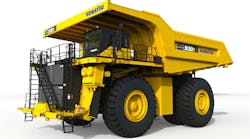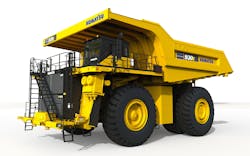This Week in Power & Motion: Komatsu Partnering with GM on Fuel Cells for Mining Equipment
There is much going on in the world of hydraulic, pneumatic and electric motion systems, from technology introductions and industry advancements to new trends and industry leaders. Each week the Power & Motion team collects the latest industry news to help keep our readers up to date on what's happening in the fluid power and electric motion control sectors as well as the industries they serve.
NFPA Grant Helps University Expand Fluid Power Education
The National Fluid Power Association's (NFPA) University Grant program is awarded to schools to help them develop fluid power education programs. Recently, a grant was given to help North Carolina Agricultural and Technical State University (NCAT) develop a Fluid Power concentration for its undergraduate engineers.
To do so, Purdue University is providing its expertise which includes developing five labs to teach key fluid power competencies identified by NFPA's industry members. The kits will be sent to NCAT once completed as well as made available on the NFPA Foundation website for use by anyone interested in them.
In addition, a professor from Purdue visited NCAT to teach a mini course and provide guidance on what is neede to build a Fluid Power Lab at the university. The grant will also help Dr. Paul Akangah, a professor at NCAT, visit Purdue and Iowa State University to see each of their fluid power labs and other educational resources.
Besides the grant, NFPA is helping NCAT create industry connections with various university faculty, fluid power industry companies and more to help establish a well rounded fluid power educational program.
READ MORE: NFPA Fluid Power Vehicle Challenge Provides Real-World Engineering Experience
Carnegie Mellon Professor Named Ansys Career Development Chair in Engineering
Simulation software company Ansys and Carnegie Mellon University (CMU) have appointed Professor Rebecca Taylor to the inaugural Ansys Career Development Chair in Engineering which recognizes engineering faculty at the university who conduct education and research in fields related to Ansys or integrate Ansys solutions into research projects and curricula.
Professor Taylor is a member of CMU's mechanical engineering department with a research emphasis on combining microfabrication and nanofabrication to create hybrid top-down, bottom-up fabricated sensors and actuators. She intends to use Ansys LS-DYNA simulation software to teach fundamental mechanics concepts as well as how to simulate micro and nanoscale structures in fluids, and methods for self-assembly states Ansys in its press release announcing Taylor's appointment.
"The endowment from Ansys will play a major role in the future of mechanical engineering curricula at CMU," said Taylor. "For example, my lab is working to address the advanced manufacturing challenges that will enable the combination of both top-down engineering processes with bottom-up engineering processes. Using Ansys software in my lab and classroom will help prepare my students to use self-assembly as a powerful tool for advanced manufacturing."
"Simulation is increasingly important in all aspects of modern engineering, so it's critical that the next generation is well versed in the concepts and software," said Prith Banerjee, chief technology officer at Ansys.
U.S. and Canada Announce Effort to Reduce Emissions from Rail Sector
Ahead of COP28, the UN's climate change conference which recently ended its 13-day run, leaders from the U.S. and Canada announced a joint effort to reduce emissions from the rail sector.
In a joint statement from United States Secretary of Energy Jennifer M. Granholm, United States Secretary of Transportation Pete Buttigieg, and Canada’s Minister of Transport, Pablo Rodriguez, it was noted both governments have a strong interest in addressing climate change. And given the role the transportation industry, including the rail sector, can play in helping reduce greenhouse gas emissions (GHG) they have created a Rail Decarbonization Task Force to achieve their common goal.
Per a press release from the DOE, the countries aim to:
- establish a joint research agenda to test the safe integration of emerging technologies, including hydrogen-powered and battery-electric locomotives;
- coordinate strategies to accelerate the rail sector’s safe transition from diesel-powered locomotives to zero-emission technologies to ensure a net-zero rail sector by no later than 2050; and
- collaborate on the development of a U.S.-Canada rail sector net-zero climate model by 2025.
Given the us of fluid power and other motion control technologies in the transportation sector, efforts like this will have impactson future designs.
New igus Mobile App uses AI to Optimize Machine Designs
igus has launched a mobile app, igusGO, which uses artificial intelligence (AI) to show how machine designs can be optimized when using the company's motion plastics technology.
Users simply have to take a photo with the app of their application and the built-in AI provides recommendations on how igus products such as plain bearings, linear guides or cable carriers can be incorporated to reduce costs and extend service life of machines. The app works with over 450 industrial applications including coffee machines, bottling plants and excavators. More applications continue to be added based on user submissions.
"Many of our customers are not aware of just how many application options there are for all our products," said Frank Blase, CEO at igus, in the company's press release announcing the launch of the new mobile app. "The igusGO app is intended to be a source of inspiration. At the same time, we want to open the app to a community where everyone can participate and share their projects with others."
igusGO is available for free download on Android, iOS, and as a web version at app.igusgo.cloud, currently in English and German. The company will continue to update the app with new features such as an AI chatbot to answer user questions.
Komatsu Partnering with GM on Hydrogen Fuel Cell Powered Mining Truck
Heavy equipment manufacturer Komatsu is partnering with General Motors (GM) to co-develop a hydrogen fuel cel power module which will be used in Komatsu's 930E electric drive mining truck. The companies plan to jointly design and validate the technology.
Hydrogen is seen as a viable diesel alternative in heavy-duty equipment such as that used in mining because of its zero tailpipe emissions and ability to provide the power necessary for large machines. In addition, it is lightweight and quick to refuel, helping overcome issues related to battery-electric technologies which can cause more weight to be added to a vehicle and require longer charge times.
Komatsu, like many OEMs, understands there is no one solution that will suit all application needs and therefore is developing hydrogen fuel cell and battery-electric options for its construction and mining equipment.
The companies plan to test the first prototype powered by GM's HYDROTEC fuel cell technology in the mid-2020s at Komatsu's Arizona Proving Grounds research and developemnt facility. They anticiapted the mining truck will be by over 2 megawatts of HYDROTEC power cubes.
"Finding new ways to power the equipment our customers need to do the vital work of mining and construction is a critical part of our commitment to supporting a more sustainable future," said Dan Funcannon, vice president of North America engineering and development for Komatsu, in the company's press release announcing the partnership. "This is essential work that requires cross-industry collaboration."
"At GM, we believe fuel cells can play an integral role in a zero-emissions future, helping to electrify heavier-duty applications, beyond passenger vehicles," said Charlie Freese, executive director of GM’s Global HYDROTEC business. "Mining trucks are among the largest, most capable vehicles used in any industry, and we believe hydrogen fuel cells are best suited to deliver zero emissions propulsion to these demanding applications."
READ MORE: Hydrogen-Battery Hybrid System Drives World's Largest Mine Haul Truck





